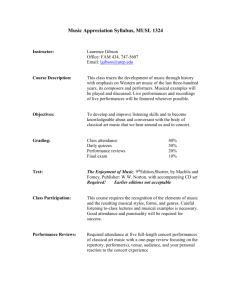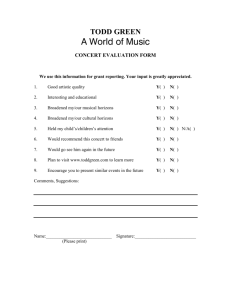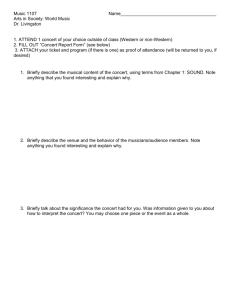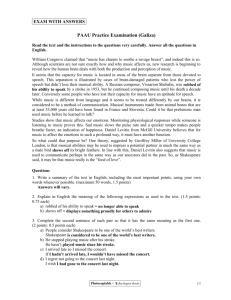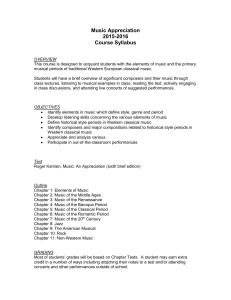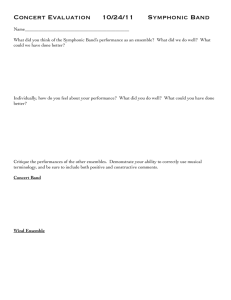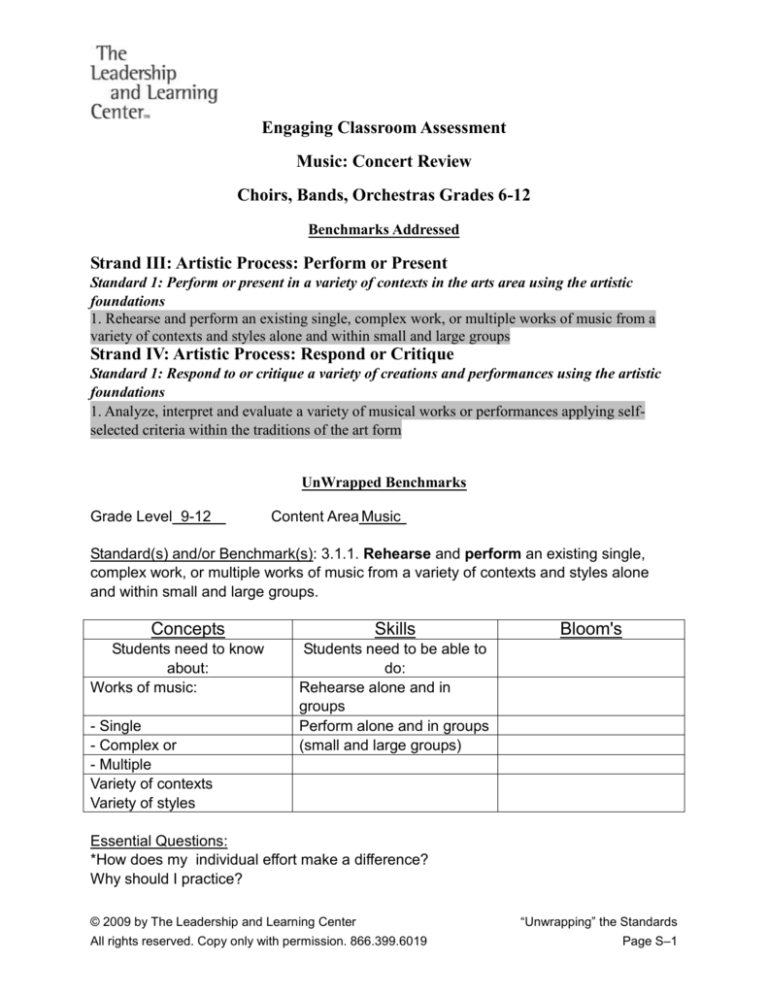
Engaging Classroom Assessment
Music: Concert Review
Choirs, Bands, Orchestras Grades 6-12
Benchmarks Addressed
Strand III: Artistic Process: Perform or Present
Standard 1: Perform or present in a variety of contexts in the arts area using the artistic
foundations
1. Rehearse and perform an existing single, complex work, or multiple works of music from a
variety of contexts and styles alone and within small and large groups
Strand IV: Artistic Process: Respond or Critique
Standard 1: Respond to or critique a variety of creations and performances using the artistic
foundations
1. Analyze, interpret and evaluate a variety of musical works or performances applying selfselected criteria within the traditions of the art form
UnWrapped Benchmarks
Grade Level 9-12
Content Area Music
Standard(s) and/or Benchmark(s): 3.1.1. Rehearse and perform an existing single,
complex work, or multiple works of music from a variety of contexts and styles alone
and within small and large groups.
Concepts
Students need to know
about:
Works of music:
- Single
- Complex or
- Multiple
Variety of contexts
Variety of styles
Skills
Bloom's
Students need to be able to
do:
Rehearse alone and in
groups
Perform alone and in groups
(small and large groups)
Essential Questions:
*How does my individual effort make a difference?
Why should I practice?
© 2009 by The Leadership and Learning Center
All rights reserved. Copy only with permission. 866.399.6019
“Unwrapping” the Standards
Page S–1
How does one prepare for a performance?
How does one learn a new work?
Big Idea:
*Individual focused effort contributes to the success of the individual as well as the
greater good
*Preparation is important in life
Cooperation is the conviction that nobody can get there unless everyone gets there
The ability to direct individual accomplishments for group objectives
Rehearsal skills are life skills.
Rehearsal leads to knowing a work and/or performance
Tasks:
Preparation of selected music for concert
Student performs for a variety of audiences and in a variety of settings
Student understands how their performance influences the audience.
Preparation of selected music for concert
Practice logs to record times with reflective questions. (Need journal/cards to reflect
discussion at home and self-reflection. Possible practice time requirements.)
Smart Music (students can reflect on their individual recorded practice)
Students develop short and long term goals to prepare for a performance (personal
practice and rehearsal).
© 2009 by The Leadership and Learning Center
All rights reserved. Copy only with permission. 866.399.6019
“Unwrapping” the Standards
Page S–2
Grade Level 9-12
Content Area Music
Standard(s) and/or Benchmark(s): 4.1.1. Analyze, interpret and evaluate a variety of
musical works or performances applying self-selected criteria within the traditions of
the art form.
Concepts
Skills
Students need to know about:
Students need to be able to
do:
Analyze
Variety of musical works and
performances.
Self-selected criteria
appropriate for the selected
musical tradition
Bloom's
Interpret
Evaluate
Applying self-selected
criteria
Essential Questions:
*Why would analyzing, interpreting, and evaluating be beneficial (an important life skill)?
*How does presentation impact perception?
How do we understand and evaluate things?
What makes music good?
Why do we need to reflect on our performances?
What are the qualities and characteristics of a great performance?
Big Idea:
*Looking at life through different lenses broadens ones perspective.
*In depth analysis leads to deeper meaning.
Different creative works (compositions) require different evaluative lenses.
We look at different things in different ways for different reasons.
Tasks:
• Student will apply criteria that they have selected in order to understand the music that
they are preparing for performance.
• Student will apply criteria that they have selected in order to compare two musical
styles or performances of the same music or others pieces paired for comparison by the
teacher.
• Students will experiment with changing the characteristics of the music in order to
compare expressive outcomes.
• Student will apply criteria that they have selected in order to evaluate their own
performance or another person/group’s performance
© 2009 by The Leadership and Learning Center
All rights reserved. Copy only with permission. 866.399.6019
“Unwrapping” the Standards
Page S–3
(see middle level curr. Map for small group assessment in order to get some criteria for
having kids make judgments about a performance)
© 2009 by The Leadership and Learning Center
All rights reserved. Copy only with permission. 866.399.6019
“Unwrapping” the Standards
Page S–4
Engaging Classroom Scenario
How Will You Engage Students in a Real-Life Challenge That Conveys the
Relevancy of the Targeted Content and Skills and Acknowledges an Audience?
S What is the situation?
Student evaluation of my readiness prior to the concert.
Student evaluation of the readiness of the performance.
C What is the challenge?
Determine the criteria for evaluation of the music performance.
Student selects appropriate criteria (possible group criteria:
Individual criteria: technique, musicianship, ensemble skills Do we need to agree on a
rubric that describes performance skills? Robb has an example. Ordway rubric?
State High School League contest form?
R What role(s) does the student assume?
Student acts as evaluator of their personal music skills.
Student acts as evaluator of the performance
A Who is the audience (preferably an external audience)?
Newspaper or radio critic
Contest judge
College entry interview (can use criteria to make evaluations)
Peers, parents, communities who are evaluating a music program
P What is the product or performance the student will demonstrate and/or create?
A critique/reflection of their performance group's concert in tandem with their personal
performance within the concert. This could be in the form of article, broadcast, video,
etc.
Task #1 may be an individual self-assessment of music skills, techniques and musicianship
using criteria/rubric presented to the student.
Task #2 may be an analysis and evaluation of the group performance using criteria selected
by the student.
© 2009 by The Leadership and Learning Center
All rights reserved. Copy only with permission. 866.399.6019
“Unwrapping” the Standards
Page S–5
Synopsis of Tasks—Road Map for Tasks’ Design
Degree of
Rigor—Level
of Bloom’s
Taxonomy
Product or Performance—
What Will Students Do?
1
Comprehension/
Application
Identify and explain the criteria used for
personal music performance
2
Analysis
Examine the quality of the performance
based on the elements of performance
3
Evaluate
Evaluate/rate the performance and
justify your evaluation based on criteria
4
Synthesis
Compose a review of your performance
using the results of tasks “1, 2 and 3
Task
© 2009 by The Leadership and Learning Center
All rights reserved. Copy only with permission. 866.399.6019
Am I Using a Variety of
Knowledge-Deepening
Activities That Appeal to
a Variety of Learners?
“Unwrapping” the Standards
Page S–6
TASKS (Continued)
Full Description
Individual assessment of personal readiness for a performance.
Task #1 may be an individual self-assessment of music skills, techniques and musicianship
using criteria/rubric presented to the student.
The student will use writing techniques to evaluate their musical skills and preparedness for the
concert. The evaluation will be based on teacher-designed criteria.
Individual assessment of entire group performance.
Task #2 may be an analysis and evaluation of the group performance using criteria selected by
the student.
Following the group performance the student will create an authentic critique of the performance
based on the guidelines of a professional critic review.
© 2009 by The Leadership and Learning Center
All rights reserved. Copy only with permission. 866.399.6019
“Unwrapping” the Standards
Page S–7
Scoring Guides (Rubrics)
Scoring Guide: Concert Review - Individual assessment of personal readiness for a performance.
Uses Musical
vocabulary and
concepts to
justify response
References
composer's
intentions and
style
Evaluation of
cohesiveness of
performance
with director's
cues
Exemplary 4
Proficient 3
Developing 2
Beginning 1
Describes
performance based
on all components of
performance
skills/techniques
(tone, intonation, note
accuracy, rhythmic
accuracy,
articulation/diction,
phrasing, and other
performance factors)
and also uses
comparisons/contrasts
to other performances
experienced by the
student
Describes
performance
based on all
components of
performance
skills/techniques
(tone, intonation,
note accuracy,
rhythmic accuracy,
articulation/diction,
phrasing, and
other performance
factors)
Describes
performance
based on some
of the
components of
performance
skills/techniques
Describes
performance with
little or no
reference to the
components of
performance
skills/techniques
Shows thorough
understanding of the
composer’s intentions
(style) and also
compares/contrasts it
to another piece by
the same composer of
one of a different
composer
Shows thorough
understanding of
the composer’s
intentions (style)
Shows superficial
understanding of
the composer’s
intentions (style)
Shows no
understanding of
the composer’s
intentions (style)
Examines
responsiveness of the
group's performance
to the director’s cues
and evaluates the
director's choice of
interpretation/cues
Examines
responsiveness of
the group's
performance to
the director’s cues
Shows little
reflection of the
group's
performance in
reference to the
director’s cues
Shows no
reflection of the
group's
performance in
reference to the
director’s cues
© 2009 by The Leadership and Learning Center
All rights reserved. Copy only with permission. 866.399.6019
“Unwrapping” the Standards
Page S–8
Reflects on
personal
performance
within the
expectations of
the group and
the director
Uses concrete model
(provided by teacher)
to compare personal
performance within
the group including
reflections on the
student's progress
throughout the
rehearsals and plans
for future
performances
Uses concrete
model (provided
by teacher) to
compare personal
performance
within the group
© 2009 by The Leadership and Learning Center
All rights reserved. Copy only with permission. 866.399.6019
Uses no concrete
model (provided
by teacher) to
compare
personal
performance
within the group
Does not
compare
personal
performance
within the group
“Unwrapping” the Standards
Page S–9

